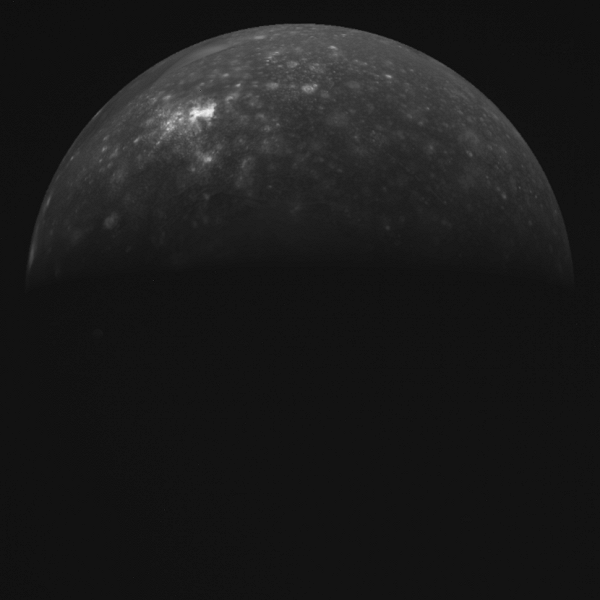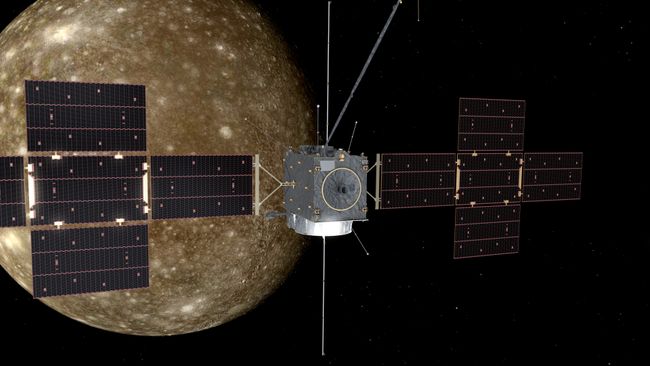It looks like JUICE will overcome all technical difficulties associated with signal delay and explore Jupiter's moon on its own
Although a full seven years remain before its scheduled arrival at Jupiter, the JUpiter ICy moons Explorer (JUICE) mission continues to move closer to its goal. A recent test launch simulated the mission's spacecraft flying past Jupiter's icy moon — Callisto.
Launched a year ago from Europe's spaceport in French Guiana, the explorer of Jupiter's icy moons, known by the acronym JUICE, is now in the inner solar system. Here it prepares for a series of gravity assist maneuvers that will put it on a trajectory that will bring it closer to Jupiter in 2031. The first stop on this route will be Jupiter's farthest moon, Callisto. This is just the first of 35 planned flybys of the moons Callisto, Ganymede and Europa before the spacecraft enters orbit around Ganymede.
At the European Space Operations Center (ESOC) in Germany, the mission team is already actively preparing for the first flight of JUICE, using an engineering model of the spacecraft for training. This is an exact replica of the flight model, with similar hardware, software and instruments. The only difference is that this model is located in a «clean room» in Darmstadt.
One of the main difficulties facing the JUICE mission, as in any space expedition — time delay in the transmission of signals between the spacecraft and the Earth. This time can vary from 33 minutes when Jupiter is closer to Earth to 54 minutes when the planet is on the opposite side of the solar system. Therefore, JUICE is equipped with software that allows it to make decisions and act autonomously, bypassing the need to transmit commands.
One of the situations where the importance of JUICE's autonomy is palpable — observation of the surface of Callisto during flybys. Since the craft's position cannot be accurately predicted as it passes through Callisto's gravitational field, the onboard computer must independently adjust the craft's orientation to focus its instruments on objects of interest on the surface to within a fraction of a degree.
«It is important to us that JUICE is able to react independently, having its own “eyes” and “brain”. When Callisto appears in the field of view of the navigation camera, the device must be able to independently identify important objects on the surface of the satellite, carefully set the direction of the instruments on them and then ensure their continuous observation during the flight», — emphasized Ignacio Tanco, Director of Flight Operations at JUICE.
To train the engineering model at ESOC, we had to create the illusion of flying close to Callisto by projecting computer images of the satellite’s surface into the model’s navigation system. These images simulated the orientation and phase that would be relevant for JUICE's flyby of Callisto in 2031.
Giulio Pinzan, a spacecraft operations specialist at the European Space Agency (ESA), compared the process of linking an engineering model to virtual space. He described it as analogous to strapping an immersive virtual reality headset to a model and allowing her to move around in that virtual world.
Pinzan noted that the project's navigation software had to respond to visualizations from the computer: «If JUICE “realizes” that it is approaching Callisto at the wrong angle or looking slightly out of place that direction, then you will need to fix it without the help of the mission team».

The ESOC management test was scheduled over three days, and despite the expected difficulties, each of which was a sudden test, the purpose of this training was to eliminate possible problems. Due to the complexity of the problem, the problem could not be pre-fixed using a software simulator. The JUICE team prepared for a lot of trial and error and the need to rework the software.
However, already on the first day, the engineering model successfully navigated virtual images of Callisto and maintained focus on the icy surface of the satellite.
«We admire the work of our flight dynamics team. Their mathematical calculations were accurate and allowed for a clean flyby on the very first attempts, despite the lack of experience usually obtained using software simulators. They even surprised us», — Pinzan noted.
The next phase of JUICE's real-world mission will be Moon-Earth Gravity Assistance, called LEGA for short, in August. JUICE will then fly past the Moon and, less than 24 hours later, pass by the Earth to receive a gravitational boost to increase its speed. This will be the first attempt to use such a dual gravity maneuver, but due to the size of JUICE — one of the most massive interplanetary spacecraft ever launched — additional maneuver is required to navigate it.
In 2025, JUICE will receive another gravitational assist from Venus, and then make two additional flybys of Earth in 2026 and 2029, gaining the necessary speed to leave its gravitational lock on the Sun and finally head towards Jupiter .

